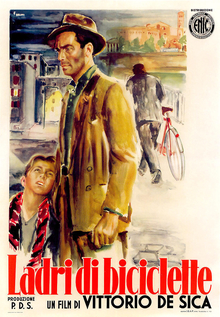The Bicycle Thief:

The Bicycle Thief (1948) is a film following the struggles of a working class Italian family, the Riccis. The husband and father, Antonio Ricci, has managed to secure a reasonably well-paying job in a poor job market which requires a bike. After selling their family's bed sheets to purchase a bike, Antonio begins his new job, only to have the bike stolen. What follows is Antonio's increasingly desperate attempts, alongside his son, to find the thief and recover his bike. Eventually, Antonio gets desperate enough to attempt to steal a bike, after which he is caught. Upon seeing Antonio's son in tears, the owner of the bike lets Antonio off with a warning, after which both Antonio and his son walk home in tears.
This movie has been put on many top ten movies of all time lists, with good reason. It is well shot, has a moving story and had a poignant ending. The film was a reasonably entertaining watch, however was let down by it's poor sound quality and infrequent subtitles.
In the film, the bike could represent hope of financial stability for the family.
It was not evident that the actors were not professional, and their non-professional status added an element of realism to their character's emotions.
The father starts as an upstanding citizen, only to become more and more desperate over the course of the film, ending in him becoming a bicycle thief.
The son's opinion of his father initially starts as idolization, and becomes a form of betrayal as the father becomes desperate, hits him and steals bikes, and ends with a sense of camaraderie as they both walk crying down the street together.




